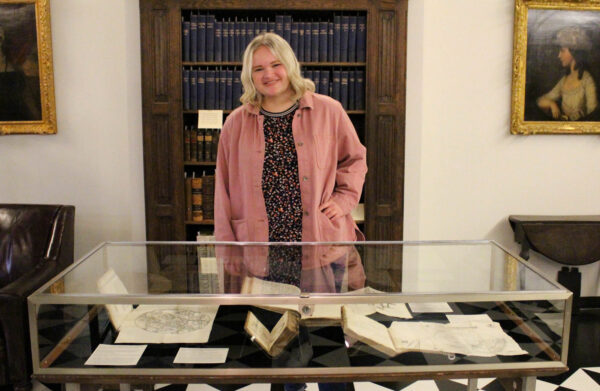Olivia Brock: a graduate on a ‘quest for knowledge’
In the Special Archives room in the basement of the Merrill-Cazier Library, Olivia Brock wanders around, her gold hair and pink denim jacket standing out against deep brown bookcases. Shiny display cases surround her as she walks.
Brock, a graduating senior double majoring in art history and statistics, points at one of the glass cases, a glint in her eye, and begins to explain the connection between art and science.
The yellowed page inside the case is marked with intricate drawings depicting historic scientific devices. The artifact is only one of dozens housed in the Special Archives room — a part of an exhibit curated by Brock for her Honors Capstone.
Brock began research during her first year at USU. Since then, she has worked in a variety of capacities in several communities at USU, seeking to expand her knowledge and understanding of the world.
“I’m motivated, I think, by a quest for knowledge,” she said.
During her time at USU, Brock has worked as an undergraduate research fellow, undergraduate teaching fellow and undergraduate writing fellow. She is also a member of USU’s honors program.
In addition, she was awarded Undergraduate Researcher of the Year at this year’s Robins Awards, along with being Valedictorian and a Caine Scholar.
Brock’s interest in research began her first year when she wrote a paper on astrolabes for a class. Astrolabes are medieval computational instruments that were used by Islamic empires hundreds of years ago.
She wanted to investigate why these scientific devices were made beautifully, usually with precious metals.
“I felt like that was really important to the objects’ kind of history and being,” Brock said.
After finishing the class, Brock received an email from the professor offering her a mentee position. That summer, she had the opportunity to go to New York City and study astrolabes in person at museums such as the MET.
Ever since, she has immersed herself in educationally enriching experiences. Last summer, she worked as an intern at the Smithsonian National Air and Space Museum.
“What a lot of people don’t know about the Air and Space Museum is that it has a really amazing collection of artwork,” Brock said.

Olivia Brock standing proudly next to her curated collection of scientific art pieces.
At the museum, Brock worked with modern art pieces representative of the history of space exploration. She sought to investigate the way scientific concepts have been visualized as artists encountered new ideas such as landing on the moon.
Throughout her college career, Brock had to figure out a lot of things for herself. As a first-generation college student, she didn’t have the connections or the understanding of the collegiate experience granted to those with family who have attended a university.
“For me, it was a lot of self-learning and just kind of figuring out things as they came up,” Brock said, “and not trying to feel like I had to know everything.”
Brock has always been interested in the arts. She loves musicals and finds solace in the power of art. “I think it’s a great expression of personality and humanity,” Brock said.
Everything changed when she chose to take an art history class in high school. It fueled her interest in art, inspiring her to learn more and take classes on the subject in college.
“I was caught contemplating lately how small decisions can impact things so significantly,” Brock said.
Brock also remarked on the significance of her decision to come to USU. She said the people she has met at USU and the relationships she’s developed as a result have helped shape her as a person and an academic.
One of the most important relationships she developed has been with Alexa Sand, an art history professor at USU and Brock’s mentor.
Brock encourages all students to find a mentor. “She’s always been so great at helping me keep perspective,” Brock said, “but also encouraging me to pursue new things, and try new experiences.”
Brock’s admiration for Sand is reciprocated. “She is incredibly self-motivated,” said Sand. “She’s probably one of the hardest working people I’ve ever met. But she works hard because her curiosity drives her.”
At this point, Sand views Brock more as a colleague than a mentee.
“I sort of saw her grow from somebody who had an interest in the intersection between science and art into somebody who could really curate her own exhibits and operate as an independent researcher,” Sand said.
Brock isn’t sure exactly what lies in her future — she doesn’t know if she’ll focus on statistics or art, if she wants to work a desk job or in a more interactive career. Regardless, she does know she wants to continue to use the knowledge she acquires to speak on the power of art.
“Being able to engage people in the arts, I think, is my dream,” Brock said.
As Brock looks through the glass casing surrounding the ancient scientific artifacts, her lips turn into a soft smile. Her voice resonates in the small room as she speaks about the passion behind her drive.
“I think it’s maybe once in a lifetime that you get a student like this,” Sand said, “and they deserve to be celebrated.”
Photo by Paige Johnson

